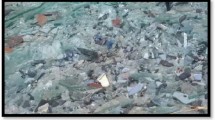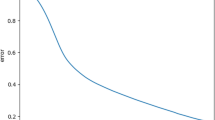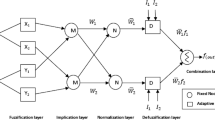Abstract
This research examines the feasibility of using washed recycled fine aggregates (WRFA) as a substitute for natural virgin aggregates in concrete. The aim is to develop novel models, based on Response Surface Method (RSM) and Artificial Neural Network (ANN), for predicting compressive strength and optimizing the results in concrete pavement development. The Central Composite Design (CCD) approach is utilized to optimize the concrete's strength parameters, considering WRFA, Zirconia Silica Fume (ZSF), and Steel Slag (SS) content. The RSM model does not perform well for compressive strength and split tensile strength, prompting the development of an ANN model to enhance prediction accuracy. The optimal proportion of training, testing, and validation datasets is determined as 70%, 15%, and 15% respectively. The ANN model, evaluated using Coefficient of Determination (R2) and Mean Square Error (MSE), outperforms the RSM model with higher prediction accuracy and better model fit. The findings highlight the potential of WRFA in concrete mixes, offering the ability to achieve desired strength levels surpassing conventional concrete. This research underscores the viability of WRFA as a sustainable construction material, supporting the development of environmentally friendly concrete pavements.















Similar content being viewed by others
Data availability
Some or all data, models, or code generated or used during the study are available from the corresponding author by request.
References
(BIS), B. of I. S. (1970). IS 383: 1970 Specification for Coarse and Fine Aggregates From Natural Sources for Concrete. Indian Standards, 1–24.
Abraham, S. M., & Ransinchung, G. D. R. N. (2018). Strength and permeation characteristics of cement mortar with reclaimed asphalt pavement aggregates. Construction and Building Materials, 167, 700–706. https://doi.org/10.1016/j.conbuildmat.2018.02.075
Abut, Y., & Yildirim, S. T. (2022). An investigation on the durability properties of RAP-containing roller compacted concrete pavement. Euro J Environ Civ Eng, 26(2), 802–818. https://doi.org/10.1080/19648189.2019.1679672
Adamu, M., Louay, M., Ibrahim, Y. E., Shabbir, O., Alanazi, H., & Louay, A. (2022). Case studies in construction materials modeling and optimization of the mechanical properties of date fiber reinforced concrete containing silica fume using response surface methodology. Case Studies in Construction Materials, 17(October), e01633. https://doi.org/10.1016/j.cscm.2022.e01633
Arabyarmohammadi, H., Sharbatdar, M. K., & Naderpour, H. (2022). Experimental Investigation of Mix Proportions Effects on Roller-Compacted Concrete Properties Using Response Surface Methodology. International Journal of Pavement Research and Technology, (0123456789). https://doi.org/10.1007/s42947-022-00177-8
Bheel, N., Osman, M., Ali, A., Shafiq, N., Almujibah, H. R., Awoyera, P., et al. (2023). Utilization of millet husk ash as a supplementary cementitious material in eco-friendly concrete: RSM modelling and optimization. Structures, 49(February), 826–841. https://doi.org/10.1016/j.istruc.2023.02.015
Brand, A. S., & Roesler, J. R. (2016). Expansive and concrete properties of SFS–FRAP aggregates. Journal of Materials in Civil Engineering, 28(2), 04015126. https://doi.org/10.1061/(asce)mt.1943-5533.0001403
Brand, A. S., & Roesler, J. R. (2017). Bonding in cementitious materials with asphalt-coated particles: Part I—The interfacial transition zone. Construction and Building Materials, 130, 171–181. https://doi.org/10.1016/j.conbuildmat.2016.10.019
Costa, J. O., Borges, P. H. R., dos Santos, F. A., Bezerra, A. C. S., Blom, J., & Van den bergh, W. (2021). The effect of reclaimed asphalt pavement (RAP) aggregates on the reaction, mechanical properties and microstructure of alkali-activated slag. CivilEng, 2(3), 794–810. https://doi.org/10.3390/civileng2030043
Debbarma, S., Ransinchung, G. D., Singh, S., & Sahdeo, S. K. (2020). Utilization of industrial and agricultural wastes for productions of sustainable roller compacted concrete pavement mixes containing reclaimed asphalt pavement aggregates. Resources, Conservation and Recycling, 152(August 2019), 104504. https://doi.org/10.1016/j.resconrec.2019.104504
Debbarma, S., Singh, S., & R.N, G. D. R. (2019). Laboratory Investigation on the Fresh, Mechanical, and Durability Properties of Roller Compacted Concrete Pavement Containing Reclaimed Asphalt Pavement Aggregates. Transportation Research Record. https://doi.org/10.1177/0361198119849585
Diptikanta Rout, M. K., Biswas, S., & Sinha, A. K. (2023). Evaluation of Mechanical Properties of Rigid Pavement with High RAP Content. In M. V. L. R. . H. M. . Anjaneyulu & Shriniwas S. Arkatkar; Veeraragavan .A (Eds.), Recent Advances in Transportation Systems Engineering and Management (pp. 285–298). Springer, Singapore. https://doi.org/10.1007/978-981-19-2273-2_20
Duan, Z. H., Kou, S. C., & Poon, C. S. (2013). Prediction of compressive strength of recycled aggregate concrete using artificial neural networks. Construction and Building Materials, 40, 1200–1206. https://doi.org/10.1016/j.conbuildmat.2012.04.063
El Euch Khay, S., El Euch Ben Said, S., Loulizi, A., & Neji, J. (2015). Laboratory investigation of cement-treated reclaimed asphalt pavement material. Journal of Materials in Civil Engineering, 27(6), 04014192. https://doi.org/10.1061/(asce)mt.1943-5533.0001158
Getahun, M. A., Shitote, S. M., & Abiero Gariy, Z. C. (2018). Artificial neural network based modelling approach for strength prediction of concrete incorporating agricultural and construction wastes. Construction and Building Materials, 190, 517–525. https://doi.org/10.1016/j.conbuildmat.2018.09.097
Hammoudi, A., Moussaceb, K., Belebchouche, C., & Dahmoune, F. (2019). Comparison of artificial neural network (ANN) and response surface methodology (RSM) prediction in compressive strength of recycled concrete aggregates. Construction and Building Materials, 209, 425–436. https://doi.org/10.1016/j.conbuildmat.2019.03.119
Hossiney, N., Sepuri, H. K., Mohan, M. K., Chandra K, S., Lakshmish Kumar, S., & Thejas, H. K. (2020). Geopolymer concrete paving blocks made with Recycled Asphalt Pavement (RAP) aggregates towards sustainable urban mobility development. Cogent Engineering, 7(1), 0–25. https://doi.org/10.1080/23311916.2020.1824572
IRC 44. (2017). Guidelines for Cement Concrete Mix Design for Pavements. Indian Roads Congress.
Kaveh, A., Gholipour, Y., & Rahami, H. (2008). Optimal design of transmission towers using genetic algorithm and neural networks. International Journal of Space Structures, 23(1), 1–19. https://doi.org/10.1260/026635108785342073
Kaveh, A., & Khavaninzadeh, N. (2023). Efficient training of two ANNs using four meta-heuristic algorithms for predicting the FRP strength. Structures, 52(February), 256–272. https://doi.org/10.1016/j.istruc.2023.03.178
Naderpour, H., Rafiean, A. H., & Fakharian, P. (2018). Compressive strength prediction of environmentally friendly concrete using artificial neural networks. Journal of Building Engineering, 16(January), 213–219. https://doi.org/10.1016/j.jobe.2018.01.007
Ofuyatan, O. M., Agbawhe, O. B., Omole, D. O., Igwegbe, C. A., & Ighalo, J. O. (2022). RSM and ANN modelling of the mechanical properties of self-compacting concrete with silica fume and plastic waste as partial constituent replacement. Cleaner Materials, 4(March), 100065. https://doi.org/10.1016/j.clema.2022.100065
Paluri, Y., Mogili, S., Mudavath, H., & Pancharathi, R. K. (2019). A study on the influence of steel fibers on the performance of fine reclaimed asphalt pavement (FRAP) in pavement quality concrete. Materials Today, 32(xxxx), 657–662. https://doi.org/10.1016/j.matpr.2020.03.147
Rafiq, W., Napiah, M., Zainab, N., Hartadi, M., Salah, W., Imran, M., et al. (2021). Modeling and design optimization of reclaimed asphalt pavement containing crude palm oil using response surface methodology. Construction and Building Materials, 291, 123288. https://doi.org/10.1016/j.conbuildmat.2021.123288
Ray, S., Haque, M., Ahmed, T., & Nahin, T. T. (2021). Journal of King Saud University—Engineering Sciences Comparison of artificial neural network ( ANN ) and response surface methodology (RSM) in predicting the compressive and splitting tensile strength of concrete prepared with glass waste and tin ( Sn ) can fiber. Journal of King Saud University—Engineering Sciences, (xxxx). https://doi.org/10.1016/j.jksues.2021.03.006
Rezaei, F., Memarzadeh, A., Davoodi, M., Dashab, M., & Nematzadeh, M. (2023). Mechanical features and durability of concrete incorporating recycled coarse aggregate and nano-silica : experimental study, prediction, and optimization. Journal of Building Engineering, 73(April), 106715. https://doi.org/10.1016/j.jobe.2023.106715
Rout et al. (2015). Investigation on the Development of Light Weight Concrete with Sintered Fly Ash Aggregate and Activated Fly Ash in Blended Cement. International Journal of Engineering Research and V4(04): 25–28. https://doi.org/10.17577/ijertv4is040081
Rout, M. K. D., Biswas, S., & Sinha, A. K. (2021). Mechanical and Durability Properties of Alccofine Used in Reclaimed Asphalt Concrete Pavements (RACP). In S. S. . Biswas, Sabyasachi. Metya , S., Kumar (Ed.), Advances in Sustainable Construction Materials (pp. 131–142). Springer, Singapore. https://doi.org/10.1007/978-981-33-4590-4_14
Rout, M. K. D., Sahdeo, S. K., Biswas, S., Roy, K., & Sinha, A. K. (2023a). Feasibility study of reclaimed asphalt pavements (RAP) as recycled aggregates used in rigid pavement construction. Materials, 16(4), 1–19. https://doi.org/10.3390/ma16041504
Rout, M. D., Biswas, S., Shubham, K., & Sinha, A. K. (2023b). A systematic review on performance of reclaimed asphalt pavement (RAP) as sustainable material in rigid pavement construction: Current status to future perspective. Journal of Building Engineering, 76, 107253. https://doi.org/10.1016/j.jobe.2023.107253.
Saboo, N., Nirmal Prasad, A., Sukhija, M., Chaudhary, M., & Chandrappa, A. K. (2020). Effect of the use of recycled asphalt pavement (RAP) aggregates on the performance of pervious paver blocks (PPB)[1] N. Saboo, A. Nirmal Prasad, M. Sukhija, M. Chaudhary, A.K. Chandrappa, Effect of the use of recycled asphalt pavement (RAP) aggregates on . Construction and Building Materials, 262, 120581. https://doi.org/10.1016/j.conbuildmat.2020.120581
Shi, X., Mukhopadhyay, A., & Zollinger, D. (2018). Sustainability assessment for portland cement concrete pavement containing reclaimed asphalt pavement aggregates. Journal of Cleaner Production, 192, 569–581. https://doi.org/10.1016/j.jclepro.2018.05.004
Shubham, K., Metya, S., & Bhattacharya, G. (2022). Reliability Analysis of Settlement of a Foundation Resting Over a Circular Void. In N. Satyanarayana Reddy, C.N.V., Krishna, A.M., Satyam (Ed.), Dynamics of Soil and Modelling of Geotechnical Problems. Lecture Notes in Civil Engineering (186th ed., pp. 133–143). Springer, Singapore. https://doi.org/10.1007/978-981-16-5605-7_13
Shubham, K., Rout, M. K. D., & Sinha, A. K. (2023). Efficient compressive strength prediction of concrete incorporating industrial wastes using deep neural network. Asian Journal of Civil Engineering, (0123456789). https://doi.org/10.1007/s42107-023-00726-x
Singh, M., Adhikari, A., Maurya, M. K., Srivastava, A., & Chhabra, R. S. (2020). Feasibility study on use of washed-reclaimed asphalt as a partial replacement of natural aggregate in dry-lean concrete as base course for rigid pavement. Journal of Materials in Civil Engineering, 32(9), 04020266. https://doi.org/10.1061/(asce)mt.1943-5533.0003339
Singh, S., Ransinchung, G. D., & Monu, K. (2019). Sustainable lean concrete mixes containing wastes originating from roads and industries. Construction and Building Materials, 209, 619–630. https://doi.org/10.1016/j.conbuildmat.2019.03.122
Funding
No funding was received for conducting this study.
Author information
Authors and Affiliations
Contributions
MKDR: Writing, original drafting & Data Interpretation. KS: Model Development, Drafting & Data Curation. SB: Conceptualization, Methodology & Supervision. AKS: Editing, Methodology, & Supervision.
Corresponding author
Ethics declarations
Conflict of interest
No potential conflict of interest in the subject matter discussed in this manuscript.
Additional information
Publisher's Note
Springer Nature remains neutral with regard to jurisdictional claims in published maps and institutional affiliations.
Rights and permissions
Springer Nature or its licensor (e.g. a society or other partner) holds exclusive rights to this article under a publishing agreement with the author(s) or other rightsholder(s); author self-archiving of the accepted manuscript version of this article is solely governed by the terms of such publishing agreement and applicable law.
About this article
Cite this article
Rout, M.K.D., Shubham, K., Biswas, S. et al. An integrated evaluation of waste materials containing recycled asphalt fine aggregates using central composite design. Asian J Civ Eng 25, 1007–1025 (2024). https://doi.org/10.1007/s42107-023-00828-6
Received:
Accepted:
Published:
Issue Date:
DOI: https://doi.org/10.1007/s42107-023-00828-6




